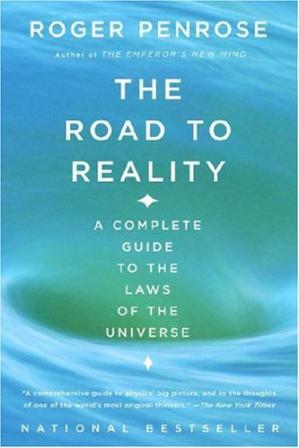The Road to RealityA Complete Guide to the Laws of the Universe
|

|
 Diese Seite wurde seit 1 Jahr inhaltlich nicht mehr aktualisiert.
Unter Umständen ist sie nicht mehr aktuell.
Diese Seite wurde seit 1 Jahr inhaltlich nicht mehr aktualisiert.
Unter Umständen ist sie nicht mehr aktuell.
 Zusammenfassungen
Zusammenfassungen
 The Road to Reality, some 1000 pages long, aims to provide a comprehensive account of our present understanding of the physical universe, and the essentials of its underlying mathematical theory. No particular mathematical knowledge on the part of the reader is assumed - the early chapters providing the essential mathematical background for the physical theories described in the remainder of the book. The aim is to convey something of an overall understanding - a feeling for the deep beauty and philosophical connotations of the subject, as well as of its intricate logical interconnections. Clearly, a work of this nature is challenging, but there is enough descriptive material to carry the less mathematically inclined reader through, as well as some 450-500, mostly hand-drawn, figures. The book provides a feeling for all the key issues and deep current controversies, and counters the common complaint that cutting-edge science is fundamentally inaccessible. The topics covered in this book include: the roles of different kinds of numbers and of geometry in physics; the ideas - and magic - of calculus and of modern geometry; notions of infinity; the physics and mathematics of relativity theory; the foundations and controversies of quantum mechanics; the standard model of particle physics; cosmology; the big bang; black holes; the profound challenge of the second law of thermodynamics; string and M theory; loop quantum gravity; twistors; fashions in science; and new directions.
The Road to Reality, some 1000 pages long, aims to provide a comprehensive account of our present understanding of the physical universe, and the essentials of its underlying mathematical theory. No particular mathematical knowledge on the part of the reader is assumed - the early chapters providing the essential mathematical background for the physical theories described in the remainder of the book. The aim is to convey something of an overall understanding - a feeling for the deep beauty and philosophical connotations of the subject, as well as of its intricate logical interconnections. Clearly, a work of this nature is challenging, but there is enough descriptive material to carry the less mathematically inclined reader through, as well as some 450-500, mostly hand-drawn, figures. The book provides a feeling for all the key issues and deep current controversies, and counters the common complaint that cutting-edge science is fundamentally inaccessible. The topics covered in this book include: the roles of different kinds of numbers and of geometry in physics; the ideas - and magic - of calculus and of modern geometry; notions of infinity; the physics and mathematics of relativity theory; the foundations and controversies of quantum mechanics; the standard model of particle physics; cosmology; the big bang; black holes; the profound challenge of the second law of thermodynamics; string and M theory; loop quantum gravity; twistors; fashions in science; and new directions. Dieses Buch erwähnt ...
Dieses Buch erwähnt ...
 Dieses Buch erwähnt vermutlich nicht ...
Dieses Buch erwähnt vermutlich nicht ... 
 Nicht erwähnte Begriffe | ACID-Prinzip |
 Tagcloud
Tagcloud
 Zitationsgraph
Zitationsgraph
 Zitationsgraph (Beta-Test mit vis.js)
Zitationsgraph (Beta-Test mit vis.js)
 3 Erwähnungen
3 Erwähnungen 
- Beyond Zero and One (Andrew Smart) (2015)

- The Feeling of Life Itself - Why Consciousness Is Widespread but Can’t Be Computed (Christof Koch) (2020)


- The Singularity is nearer (Ray Kurzweil) (2024)

- 3. Who am I?
 Co-zitierte Bücher
Co-zitierte Bücher
 Volltext dieses Dokuments
Volltext dieses Dokuments
 Bibliographisches
Bibliographisches 
 Beat und dieses Buch
Beat und dieses Buch
Beat hat dieses Buch während seiner Assistenzzeit an der ETH Zürich ins Biblionetz aufgenommen. Die bisher letzte Bearbeitung erfolgte während seiner Zeit am Institut für Medien und Schule. Beat besitzt kein physisches, aber ein digitales Exemplar. (das er aber aus Urheberrechtsgründen nicht einfach weitergeben darf). Es gibt bisher nur wenige Objekte im Biblionetz, die dieses Werk zitieren.









 Diagramm
Diagramm Geometrie
Geometrie Inflation
Inflation Konvergenz
Konvergenz Maschine
Maschine Mathematik
Mathematik Modelle
Modelle Netzwerk
Netzwerk Philosophie
Philosophie Physik
Physik Schweiz
Schweiz Statistik
Statistik Symmetrie
Symmetrie Zahlen
Zahlen Zeit
Zeit



 , 9055 kByte)
, 9055 kByte) 



 Biblionetz-History
Biblionetz-History